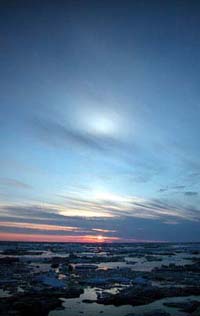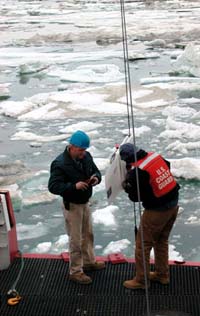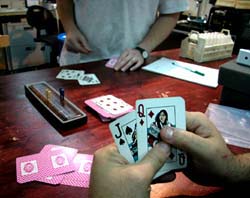|
|
 |
 |
 |
|
At about 2AM, as the sun sank low in the sky, a bright spot appeared above the sun. This “upper tangent arc” forms as a result of light refracting through ice crystals in thin, high clouds. |
|
Click to enlarge |
Daily Update
Calendar
Dispatch 17 - July 31, 2002
By C.A. Linder
Weather conditions: overcast skies, calm winds and seas, air temperature 37° F.
Necessary Evils
I stayed up late last night to watch the “sunset.” Only the sun didn’t really set, it simply dipped low towards the horizon, tinged the sky with a hint of orange, and then began crawling back up slowly into the sky. It may sound strange, but it made me think of things that I have begun to miss from the world where I live. I miss the darkness of the night and a sky full of stars. I miss the chirping of crickets and the rustling of fallen maple leaves. I miss the smell of freshly mowed grass on a summer day. It seems unreal that this world of ice exists on the same planet as the jungles of Costa Rica, the deserts of Morocco, or even the farmlands of Wisconsin. I wish I could adequately describe the vastness of the white expanse of ice, the sound of ice floes gently scraping against each other, and the smell of the cold salty air... but I don’t think there are the right kind of adjectives in the English language...
 |
 |
|
John Kemp (left) and Dan Torres (right) attach a Coastal Moored Profiler to the mooring line.
|
|
Click to enlarge |
It has occurred to me that in my description of our scientific operations aboard the Polar Star, I have focused on the most interesting or exciting things that were happening. But what about those moments in between our moorings or CTD casts? Based on the past few weeks, it takes from 30 minutes to three hours to string the mooring instruments together and slowly lower them all over the side. However, it has taken us five full days to safely deploy eight moorings... Here in the Arctic, the process of getting to your desired location is not as easy as it might seem! First, you have to contend with the ice itself. If a large field of ice is in the way, it is usually easier and more fuel-conscious to go around. Also, there could be a thick ice layer exactly where you want to stop for science... What then? It’s either wait for the ice to move, find a different spot, or try to break a hole. There are also winds and currents to take into consideration. It can take up to three hours to put a large mooring in the water, starting with the anchor and ending with the top buoy. In that amount of time the ship can often drift several miles (which in our case is the distance to the next mooring site!) It’s a tough game predicting the ship’s “set and drift” (how the ship drifts with the winds and currents) accurately enough so that when the mooring is finally ready to release, you have arrived exactly where you want the mooring to be! And, while you are drifting along with the mooring hanging below the ship, you have the added worry that you could drift into a region of shallow water and drag the mooring along the bottom...
 |
 |
|
Science crew members kill time during another bathymetry survey with a game of cribbage. |
|
Click to enlarge |
The whole process is time-consuming and nerve-racking, but that is one of the many challenges of working in the Arctic. Such challenges have kept this area relatively unknown to oceanographers, and that’s one of the reasons the Shelf-Basin Interactions project was initiated - to study this oceanographic “frontier.”
Despite the “necessary evils” of getting to our mooring locations, mapping the bottom and determining our set and drift, we still had plenty of time to deploy two more WHOI moorings today, leaving only two left for tomorrow. After that, we’ll be heading west, back to Barrow Canyon to deploy the fourth UW/UAF mooring and possibly perform some more CTD casts. I’m also hoping to see some more Arctic wildlife as we transit along the marginal ice zone again.
 Previous Dispatch
Next Dispatch Previous Dispatch
Next Dispatch

Back to Calendar
|
|




